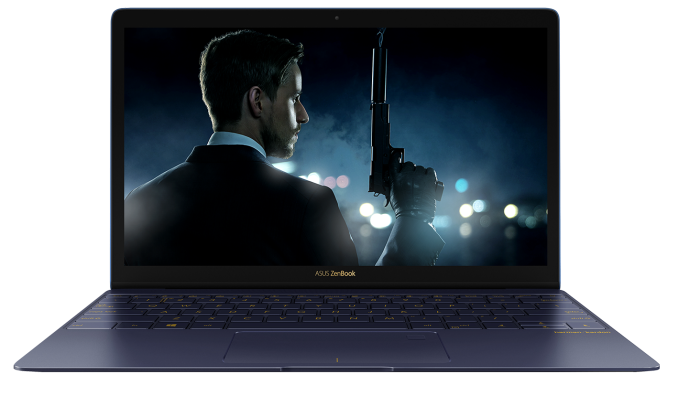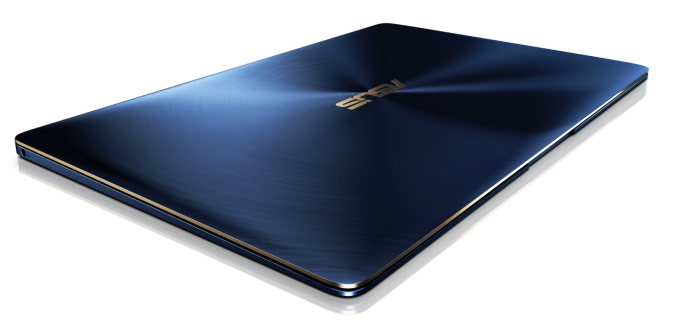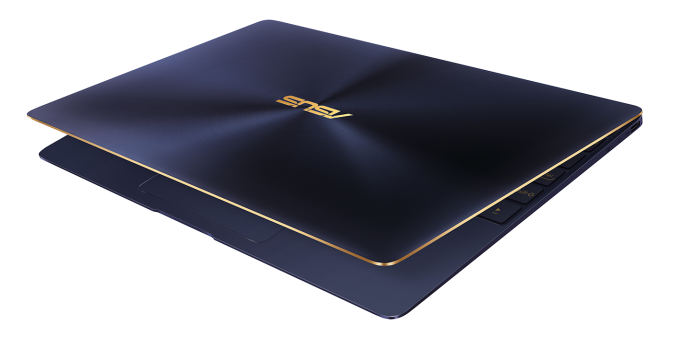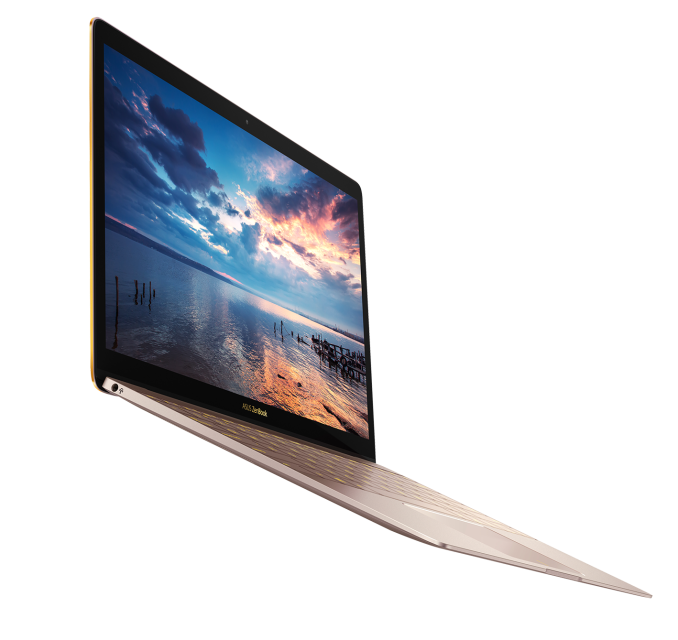ASUS Announces the Zenbook 3: A Macbook Competitor with Core i7, 16GB DRAM and 1TB SSD
by Ian Cutress on May 30, 2016 4:50 AM EST- Posted in
- Computex_2016
- Intel
- Asus
- Zenbook
- Trade Shows
- Notebooks

Computex is already a whirlwind of announcements even for day zero. At the ASUS Zenvolution press event today, the lid was lifted on the next generation of premium ASUS Zenbook: the Zenbook 3. No release date was placed, but the specification list and feature set puts it squarely in line to compete against very popular notebooks, albeit on the premium side.
The Zenbook 3 comes in at 11.9mm thin, weighing 910g, and gives a 12.5-inch display at a 1920x1080 resolution using a thin bezel display. This is similar to the XPS 13 (I’d give a nod more to the XPS 13, but it’s pretty close), but uses an aerospace grade aluminium body design similar to a Macbook but featuring a full Core i7-6500U with 16GB of LPDDR3-2133 memory. The use of a 15W Skylake-U processor means that the memory is limited to LPDDR3 rather than DDR4, which means 1.35V rather than 1.2V, but the faster 2133 MT/s memory should assist in a good number of daily tasks reliant on memory speed, such as gaming.
Storage options run up to 1TB of PCIe 3.0 SSDs (we’re double checking if these are NVMe, or SM951s), however the peak bandwidth is limited to 1700 MB/s sequential reads similar to the how Ganesh found the Intel Skylake NUCs SSD limitations – in this case the On Package Interconnect between the CPU and the integrated chipset is limited to PCIe 2.0 (though it’s worth noting that sustained writes are difficult to get above 1600 MB/s anyway).
The device will have a sole USB 3.0 Type-C port which will allow for charging and IO connectors which sounds like a Macbook, but as a difference ASUS has engineered the keyboard to allow for 0.8mm of key travel, compared to 0.4mm of the Macbook. The Zenbook 3 will have a 40 Wh battery, which ASUS rates for 9 hours of battery life but offers Quick Charge 3 which was presented as offering 60% battery charge in 49 minutes.
Other features in the mix include fingerprint login through the touchpad, a harmon/kardon enhanced audio system, Corning Gorilla Glass 4 display and the colors offered will extend to Royal Blue, Rose Gold and Quartz Grey.
| ASUS Zenbook 3 | |||
| CPUs | Intel Core i7-6500U (2C/4T, 2.5-3.1 GHz, 15W, Intel HD 520) Intel Core i5-6200U (2C/4T, 2.3-2.8 GHz, 15W, Intel HD 520) |
||
| DRAM | 16GB LPDDR3-2133 (with i7) 4GB LPDDR3-1866 (with i5) |
||
| Display | 12.5-inch 1920x1080 Slim Bezel Display Gorilla Glass 4 178-degree viewing angles |
||
| Storage | 256 GB SSD (with i5) 512 GB PCIe 3.0 x4 SSD 1TB PCIe 3.0 x4 SSD |
||
| I/O Ports | 1 x USB 3.0 Type-C | ||
| Dimensions | 296 x 191.2 x 11.9 mm | ||
| Weight | 910g | ||
| Battery | 40 Wh | ||
| Other Features | harmon/kardon audio ASUS SonicMaster audio |
||
| Pricing | $999 Core i5-6200U 4GB LPDDR3-1866 256GB SSD |
$1499 Core i7-6500U 16GB LPDDR3-1866 512GB PCIe 3.0 x4 SSD |
$1999 Core i7-6500U 16GB LPDDR3-1866 1TB PCIe 3.0 x4 SSD |
One of ASUS’ issues here will be that their Zenbook UX305 line, at $700, represents a nice product for most of their intended customers. The Zenbook 3 is supposed to be the stylish alternative, that also gets a significant specification boost for users that need the power. At the show, ASUS showed three different models and their price points:
Intel Core i5-6200U, 4GB LPDDR3-1866, 256GB SSD: $999
Intel Core i7-6500U, 16GB LPDDR3-2133, 512GB PCIe SSD: $1499
Intel Core i7-6500U, 16GB LPDDR3-2133, 1TB PCIe SSD: $1999
The entry point is aimed at users who want the style but do not need much machine – the DRAM is severely cut back, and the SSD moves down to a SATA based M.2 SSD. The Core i7 models, from $1499-$1999, means that to get the power it can get expensive, bridging the cost between the cheaper Macbooks using Core M, the Dell XPS 13, and the more powerful Core i-based notebooks moving into higher power processors. The $1999 unit comes across as a lot, especially as an upgrade over the $1499 unit (because $500 for 500GB of PCIe SSD is a bit steep), however ASUS is hoping that the style will sell.
Personally, I run a self-purchased Zenbook Infinity (Haswell i7) that is showing its age and it actually ran out of power during the ASUS Zen press event (my 3rd of the day). On some level I think the drive to thin and light and powerful can detract from what power users might need: if ASUS makes a Zenbook 3 like device with a separate sheet battery to make it 90 Wh, I might be interested.
Some users might state that a Core i-series based device and a Macbook are in two different product categories. However, during ASUS' presentation, it was constantly compared to the Macbook, and the low end price of the base model is certainly encroaching into Macbook territory. The most expensive Macbook comes with 512GB of PCIe storage and 8GB of memory for $1599 - ASUS' Zenbook 3 will give you the same storage, double the memory, ever so slightly lighter, and a full Core i7 for $100 less, although battery life is an hour in the Macbook's favor.
ASUS didn’t specify release dates, and I was told that exact US pricing is yet to be finalized, but we should expect sampling during the second half of the year. When we visit the ASUS Computex booth tomorrow, we should get a chance to see the device up close.
















34 Comments
View All Comments
aliasfox - Monday, May 30, 2016 - link
The fan may not be enough to keep the zenbook cool. I'd love to see both a MacBook Retina and the Zenbook 3 churn through half an hour of compute intensive computing to see how fast they complete. I expect the Zenbook will be faster in the first 5-10 mins, but will slow to MacBook speeds (if not slower) after it gets thermally saturated. Also, battery life under a moderate load - the Zenbook might match the MacBook under light load, but I'd be curious to see what happens with the fan on.KPOM - Monday, May 30, 2016 - link
True. That said, I split a massive OCR job between Abobe Acrobat XI running on my Haswell i7-4600-based Windows notebook and my m7 MacBook past week (running OCRkit which is native to OS X). Not entirely an equal comparison but the MacBook kept pace with the Haswell Core running Intel Power Gadget on both I noticed both had similar CPU usage and both modulated between the base and peak speeds about equally. Perhaps the time to load and unload each file within the batch was enough for the MacBook to catch its "breath," but both ran overnight without a problem.aliasfox - Monday, May 30, 2016 - link
Your Haswell notebook probably has more thermal headroom than the Zenbook, assuming it's in the 3 lbs class. Apple's not known for providing much thermal headroom either, but I hope Apple built a buffer into the MacBook for heat - otherwise it'll end up in a similar situation to the PowerMac G4 Cube all those years ago - no fan + no thermal headroom = no speed bump, ever.KPOM - Monday, May 30, 2016 - link
Core M will continue to evolve.andrewaggb - Monday, May 30, 2016 - link
Looks pretty nice... but honestly the ports situation is awful.I wish some of these companies would offer two chassis, the slim version like this and a thicker version with some ports and 20 hours battery life....
KPOM - Monday, May 30, 2016 - link
I'm guessing the port situation is such for two reasons. 1) The target customer doesn't care. 2) It would have been impossible to do while remaining thinner and lighter than the MacBook. ASUS clearly wanted that mantle. Apple told Macworld that they couldn't install a Thunderbolt 3 chip within the thermal constraints of the MacBook (i.e. they couldn't cram in the Alpine Ridge controller). Skylake M supports only 1 USB-C 3.1 Gen 1 port natively, so that's all the MacBook gets. ASUS expanded the thermal capacity by using a fan, but then uses it to install the 15W Core M to claim better performance than the MacBook (though "twice as fast" is a stretch).Having used a MacBook for the past year, I can say that it is easy to get used to not having ports. I use wireless for as much as possible (including printing, scanning, displaying externally through Apple TV) and rarely need to plug anything in.
id4andrei - Monday, May 30, 2016 - link
Judging by the 2015 Macbook review on this very site, it's actually not a stretch for Asus to claim twice as fast. Being fanless, the Macbook throttled so much that it got beat by the original Zenbook UX305, the latter sporting an inferior chipset. This new unit being actively cooled will have a much higher throttle threshold and thus perform better.KPOM - Monday, May 30, 2016 - link
Read my post above. My m7 MacBook performs as well as a Haswell i7. Skylake hasn't doubled that. The 2016 MacBook has improved quite a bit. It's as if the chassis were designed with Skylake in mind.KPOM - Wednesday, June 1, 2016 - link
However, the UX305 was in a bigger form factor. ASUS is using a similar form factor as the MacBook now. Granted, there is a fan, but there is also a lot more heat being generated since the base clock uses up more power.id4andrei - Monday, May 30, 2016 - link
BTW The port in this unit is a TB3 port.